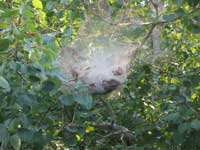Surface Roots Above The Soil Level
Poplar Roots Above The Groung - Poplars are vulnerable to living in compacted soils. When that happens they produce surface roots on top of the soil. For solutions see the file Dealing With Tree Surface Roots
Clogged Sewers, Drain Systems
Poplar Roots Underground - The roots of all Poplars grow aggressively, often forcing their way into drains and sewers causing them to clog. Dissolve 5 lbs of copper sulfate crystals in water and pour this solution down the affected drain slowly. Do not flush for several hours. Do this once a month or so until the drains are clear and the roots are killed. Usually four 1-pound applications a year serve to maintain clear drains. It is best not to plant poplars next to buildings or near any kind of drain.
Branches Splinter, Break Off
Old Age - Because poplars grow so fast, their wood is weak and brittle. Once they reach maturity they quickly become vulnerable to wind and weather damage.
Swollen, Sunken Lesions on Limbs, Trunk
Canker - Various fungi cause elongated, dark sunken cankers, or sores, in poplar trunks, limbs and twigs. It may also attack leaves early in the growing season. Sometimes the sores ooze infecting spores that spread by means of splashing rain, birds, and insects to infect new sites. Cankers may eventually girdle branches and whole trees. Because some cankers primarily attack weak trees, the most effective prevention is to keep trees vigorous by feeding, watering and controlling insects and fungus parasites of the leaves.
Brown Spotted Leaves, Fall Prematurely
Leaf Spot - Many kinds of fungi attack poplar leaves and are referred to as leaf spot. All of them cause leaves to develop brown or pale spots that are unsightly. While they are treatable with fungicide sprays, many do not consider poplars worth the trouble. The most common poplar leaf spot fungus forms brown spots with darker brown margins and causes leaves to drop prematurely. It also invades and kills twigs. Routinely collect and destroy fallen leaves to prevent the spread of the infection.
White mildew coating both sides leaves
Powdery Mildew - Powdery mildew, also caused by a fungus, is a common poplar disease. Usually a superficial infection, it causes a white mildew coating on both sides of the leaves that is rarely serious. If the disease is extensive on a valuable tree, spray foliage thoroughly with wettable sulfur once or twice at weekly intervals starting as soon as the whitish coating of the fungus is visible. Collect and discard all aboveground refuse in the fall to prevent the fungus from over wintering.
Caterpillars Make Tents In Late Summer
 |
| Jeff Ball © |
| Fall Webworm in Quaking Aspen |

